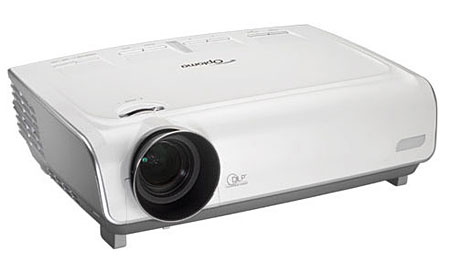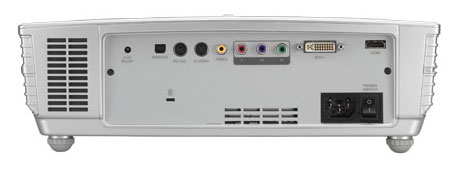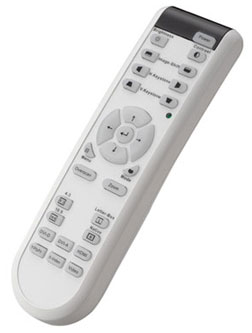Optoma HD72 DLP Projector: Short Take

- $2000
- Single-chip DarkChip2 DLP
- Resolution: 1280x768 pixels,
- Inputs: HDMI with HDCP, DVI-I with HDCP, component, composite and S-Video
- Feature Highlights: TI's BrilliantColor color processing algorithm corrects colors electronically without loss in light output typical of optical filters, 10-bit color processing, optional ceiling mount
There's no pretense here of state-of-the-art 720p DLP performance on-the-cheap, but the images I saw from my review sample of the budget priced Optoma HD72 were surprisingly impressive. While it's bright enough for use with a little ambient lighting, you won't see it at its best until it's set up properly in a light-controlled room.
I did most of my viewing using the HDMI input. Starting with the negatives, the HD72 is clearly softer looking than the best single-chip, 720p DLP projectors, with the differences most obvious on HD DVD. The best HD DVDs go from drop-dead gorgeous on the $12,500 Yamaha DPX-1300 to merely impressive on the Optoma. But they are still clearly high-definition.

Incidentally, the HDMI output of the Toshiba HD-A1 HD DVD player would not lock onto the HD72's HDMI input until I downloaded the player's firmware upgrades. But I experienced difficulty establishing a solid HDMI link from the HD-A1 to at least one other display (the SIM2 C3X projector), strongly suggesting that the cause of the misconnection was in the player (before it was updated), not the Optoma.
The sweet spot on the manual focus is very small, and the focus is also highly interactive with the manual zoom control. Even a small movement of the zoom de-focuses the lens.
A high vertical lens offset requires a very low table for any reasonable screen height (though this might be a plus in a ceiling mount). No physical lens shift adjustment is provided (though there is a small horizontal electronic image shift).
 DLP rainbows (color separation artifacts) were more obvious on the Optoma than on some other (more expensive) DLP projectors. But they were not a frequent distraction in spite of the fact that I am very sensitive to them.
DLP rainbows (color separation artifacts) were more obvious on the Optoma than on some other (more expensive) DLP projectors. But they were not a frequent distraction in spite of the fact that I am very sensitive to them.
I measured a peak contrast ratio of 838:1 (15.09 foot-Lamberts peak white, 0.018fL video black) with the lamp's Bright Mode set to On, and 828:1 (11.6/0.014) with Bright Mode Off. While these numbers suggest poor black level and shadow detail, in practice the blacks were satisfactory, though sometimes just a bit gray looking. The fact that blacks and contrast were far from state-of-the-art was no surprise at this price, but they didn't detract much from my enjoyment of the Optoma's strengths.
I obtained the best image with the Mode control on Cinema, the Degamma on Film, the ImageAI Off, and the Color Temperature on "0," which gave the best out-of-box result—about 7000K over the full brightness spectrum from high to low. But a slight recalibration did produce color temperature impressively close overall to the D6500 standard. I also found that both BrilliantColor (set to 3) and TrueVivid (set to 1) were more useful than the non-standard controls in many of the other video displays I've tested. But I saw no benefit to the Image AI feature (said to dynamically adjust the brightness of the lamp).
I also preferred the image with the lamp set to Bright Mode. This resulted in virtually no subjective degradation in the blacks but produced an image with noticeably more punch and dimensionality.
It's also notable that the HD72 is relatively quiet even with the lamp cranked up in Bright Mode, and without allowing for its very small size. The remote, which is essentially the same remote included with the Optoma HD7100, is also well laid out and illuminated. The overscan is low—and adjustable. And the projector performed shockingly well (from very good to excellent) on all of my scaling and deinterlacing tests.
I did not have the Mitsubishi HC3000 on hand for a direct comparison, but the Optoma does offer better 480i deinterlacing with an HDMI input and a more accurate gray scale both before calibration and (marginally) post-calibration as well. On the other hand, the Mitsubishi did produce deeper blacks, resulting in a significantly better measured contrast ratio. It also offers higher peak light output with its iris open, though it produces its best picture with the iris engaged and in a darkened room. (The HC3000 lists for $2500, though I've seen it for virtually the same price as the Optoma from on-line retailers.)
If you can accommodate a light-controlled room and add a good screen, the Optoma HD72 provides a serious alternative to a $2000-$3000 rear projection DLP. It's an excellent value and will provide a highly pleasing image, not to mention a true, big-screen, home theater experience that the far smaller screens in one-piece televisions cannot duplicate.





























































